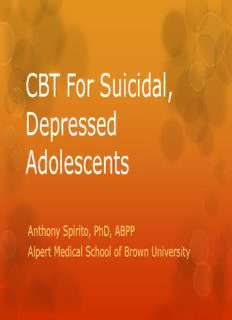
Assessment and Treatment of Adolescent Suicidal Behavior PDF
Preview Assessment and Treatment of Adolescent Suicidal Behavior
CBT For Suicidal, Depressed Adolescents Anthony Spirito, PhD, ABPP Alpert Medical School of Brown University DISCLOSURES None Acknowledgements Sponsors Major Collaborators on American Foundation for Treatment Studies Suicide Prevention Van Amerigen Foundation Christianne Esposito- Smythers, Ph.D. Harvard Pilgrim Research Foundation Deidre Donaldson, National Institute on Alcohol Ph.D. Abuse and Alcoholism (AA14191; AA020705) Jeffrey Hunt, M.D. National Institute of Mental Jennifer Wolff, Ph.D. Health (57349; 01783; 66014;082211;083092;086 606;099703) I C o n c e p t u a l Model II CBT for Adolescent Depression- Effects on Suicidality III Managing Suicidality in Therapy IV Working with Parents during Suicidal Crises V CBT Techniques for Suicidality VI Special Circumstances – Alcohol Abuse and Suicidality CBT MODEL OF ADOLESCENT SUICIDAL BEHAVIOR Trigger Cognitive Affect SUICIDE Suicidal Distortion & Dysregulati ATTEMPT Thinking Deficiency on Maladaptive Behaviors Spirito, Esposito-Smythers, et al., 2012 Predisposing Vulnerabilities This model posits that there is a predisposing vulnerability among youth who attempt suicide including: Significant genetic predisposition toward psychopathology (Brent et al, 2008) Exposure to significant negative life events, such as a history of abuse or neglect (King & Merchant,2008) Predisposing Vulnerabilities Adverse parenting resulting from parental psychopathology (Melhem et al, 2007) Peer victimization and bullying ) (Kim & Leventhal,2008 Vulnerabilities make it more likely that they will experience maladaptive cognitive, behavioral, and emotional responses to acute stressors STRESSORS Stress, typically from an interpersonal conflict, may initially trigger a depressive episode and/or suicidal crisis in predisposed adolescents. Higher catastrophizing, selective abstraction, overgeneralization, personalization and total cognitive errors have been found in suicidal compared to non-suicidal adolescent inpatients with a mood disorder (Brent et al, 1990) PROBLEM-SOLVING DEFICITS , Predisposed youth may also experience difficulties generating and/or selecting solutions to a stressor. Suicidal adolescents report greater difficulty generating and implementing effective alternative solutions to problems compared to non-suicidal adolescents (Adams & Adams, 1996) Suicidal youth are also more likely to view problems as irresolvable (Orbach et al, 1999) AFFECT DYSREGULATION This difficulty in cognitive processing and problem-solving, which is also characteristic of depressed adolescents, can result in negative affect including anger and a worsening of the current mood state ) (Daniel et al, 2009 Suicidal adolescents report greater difficulty regulating their internal states and using affect regulation skills compared to non- symptomatic adolescents (Fritsch et al, 2000)
Description: